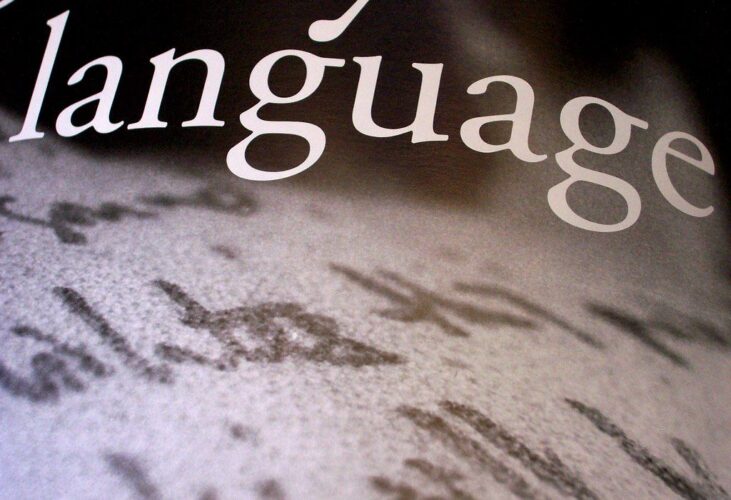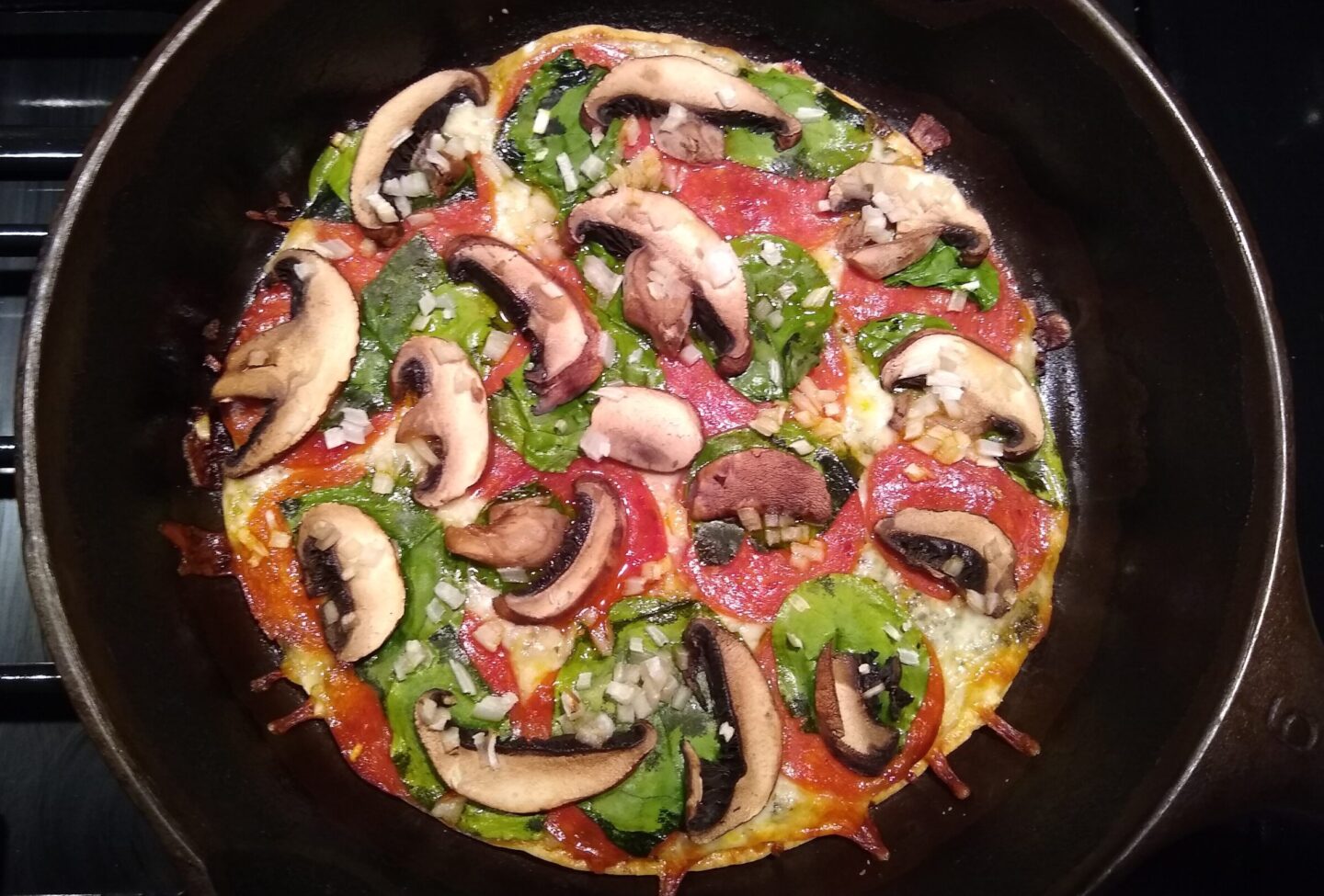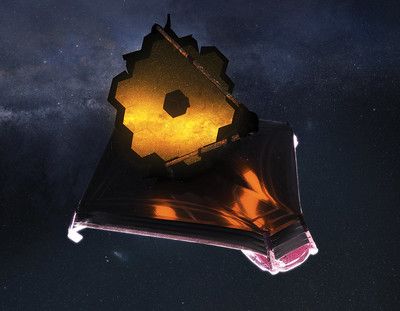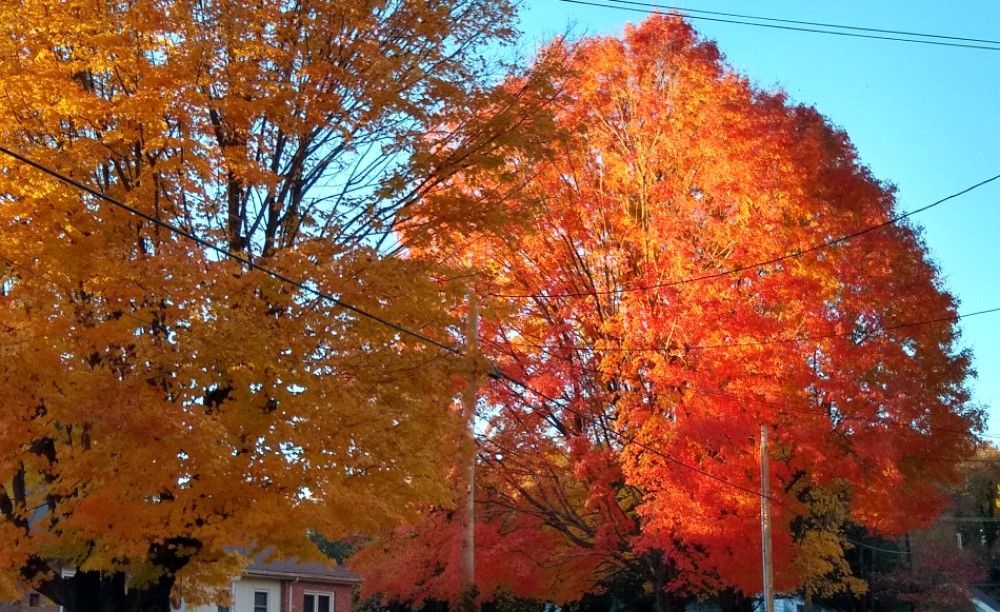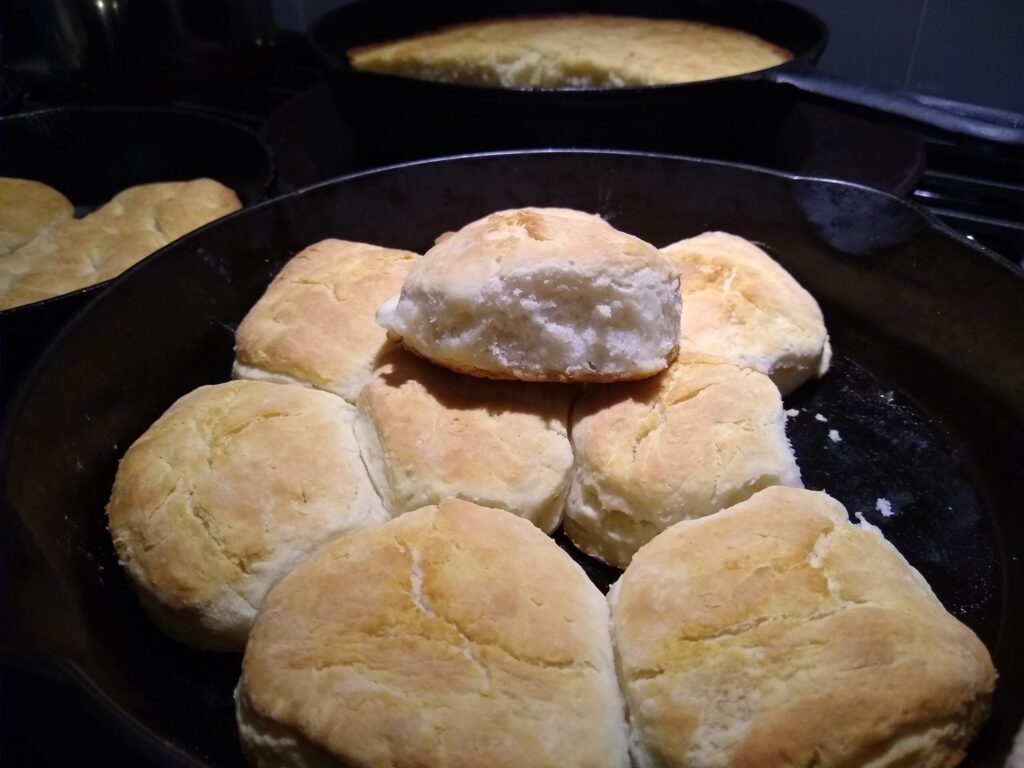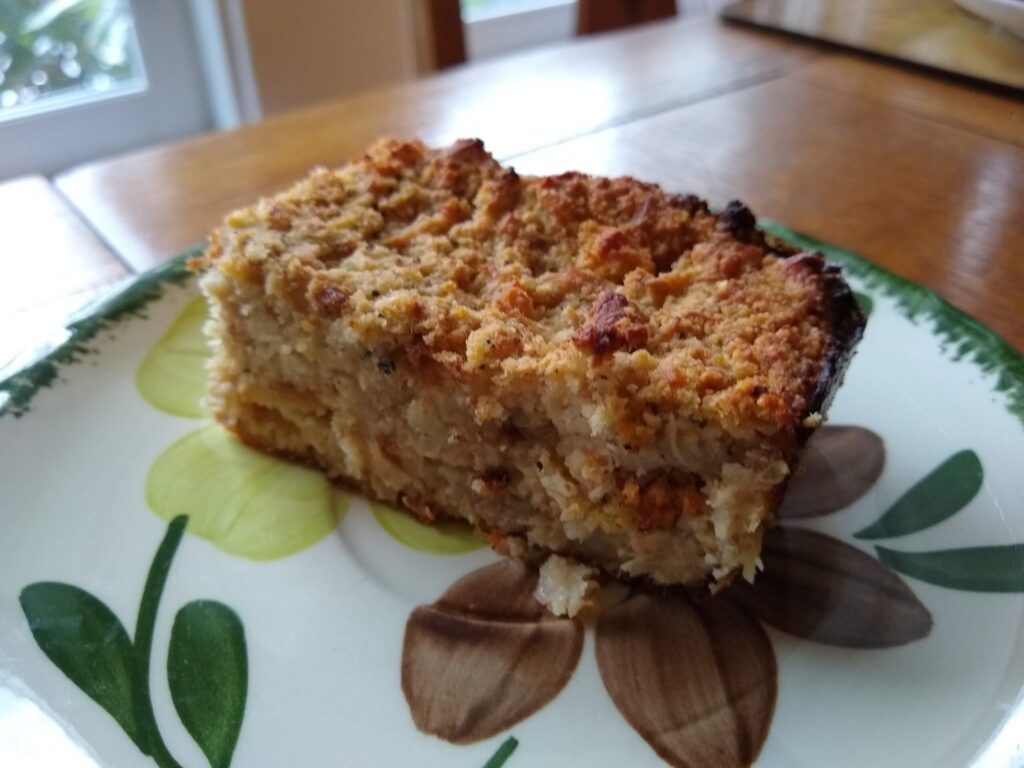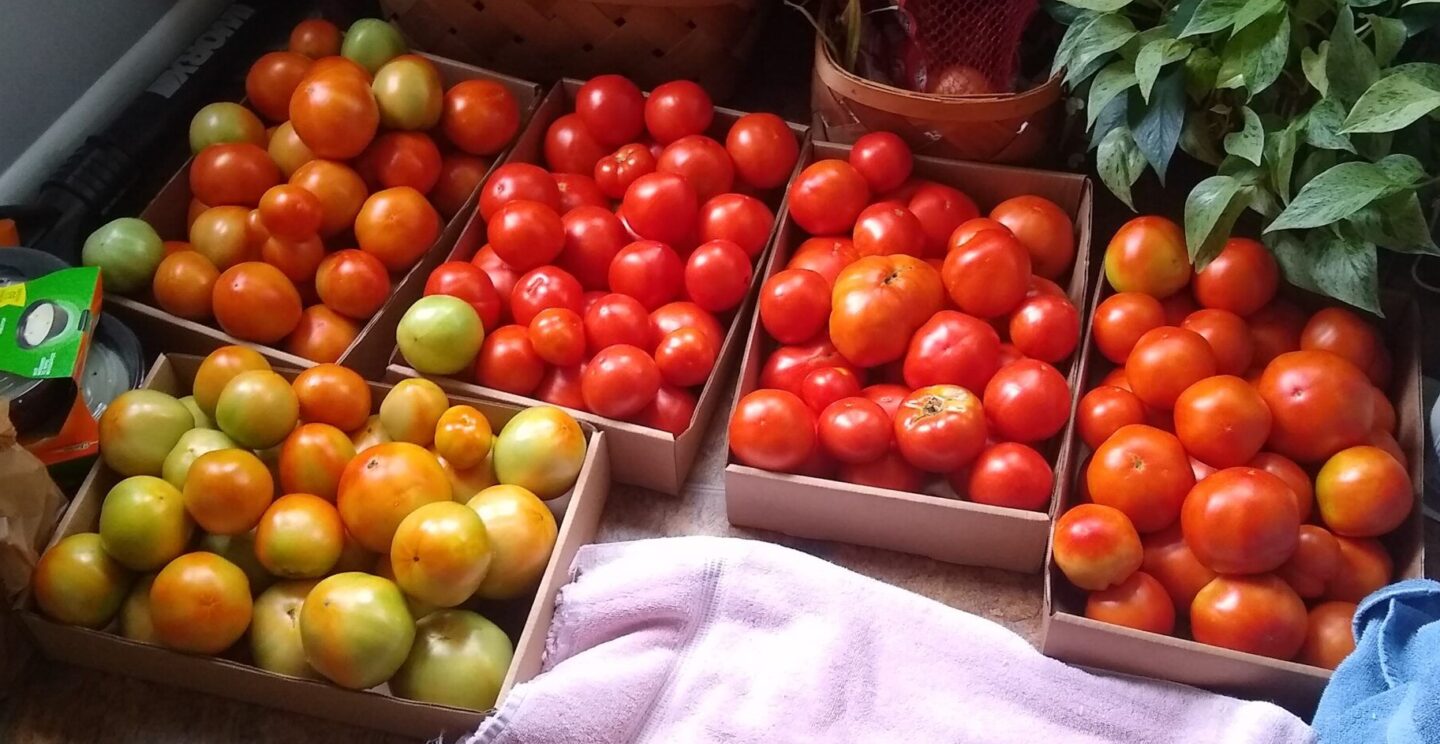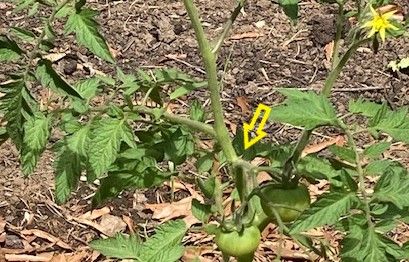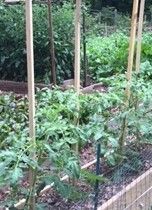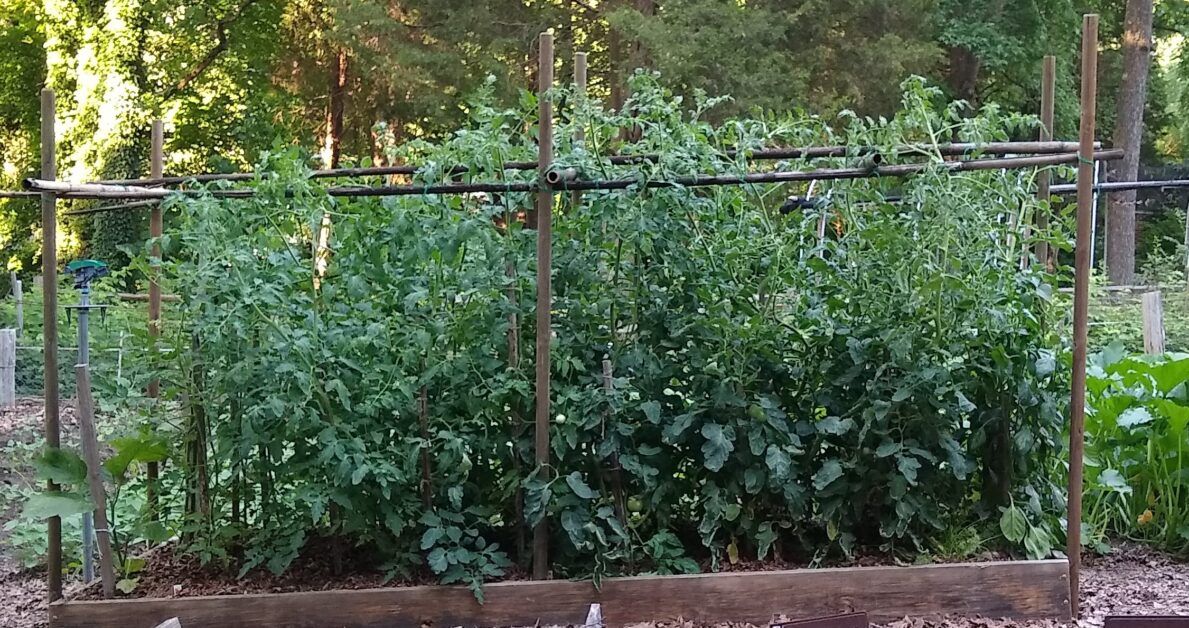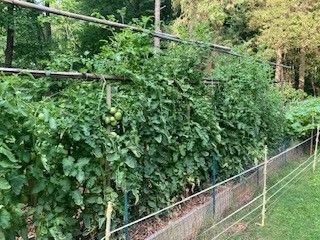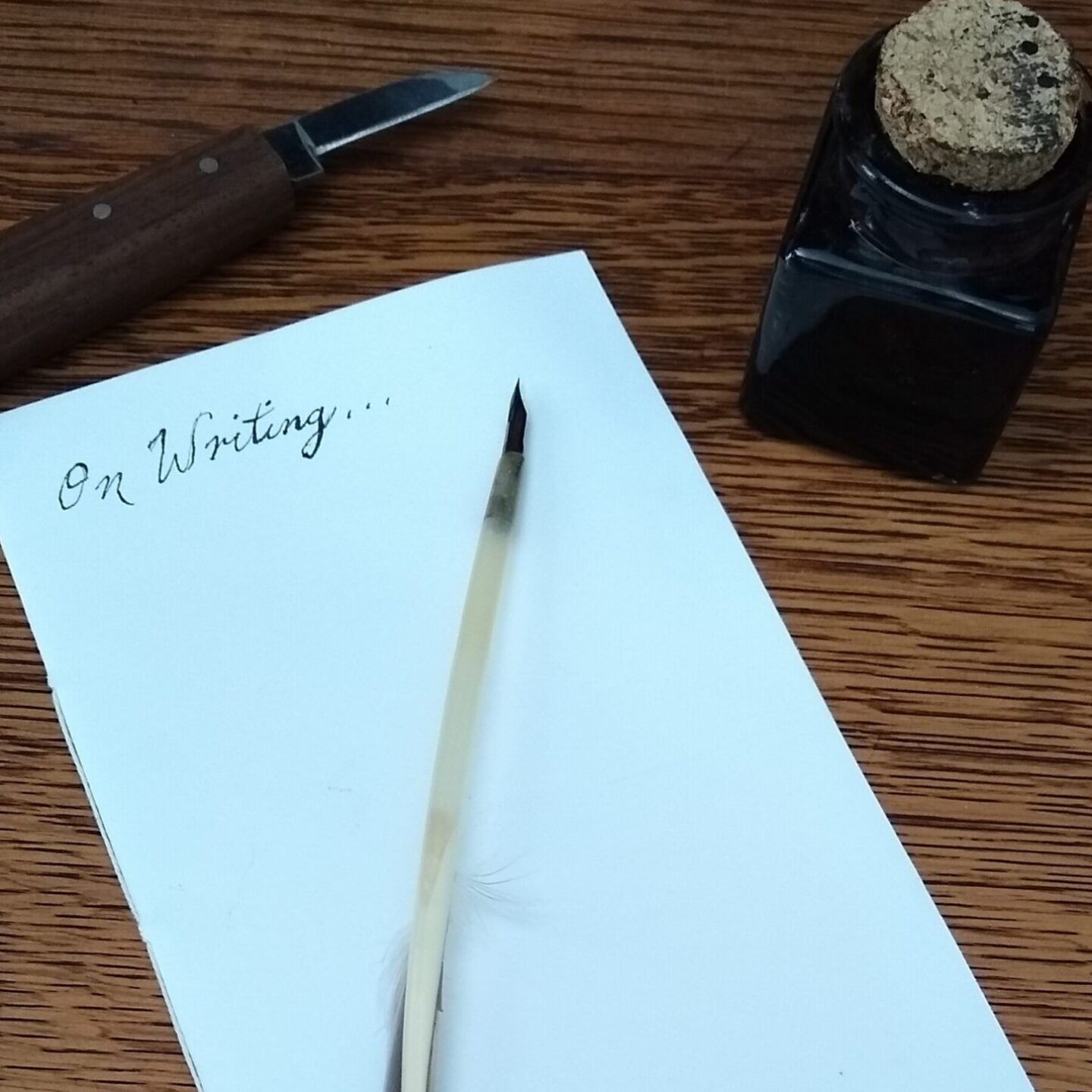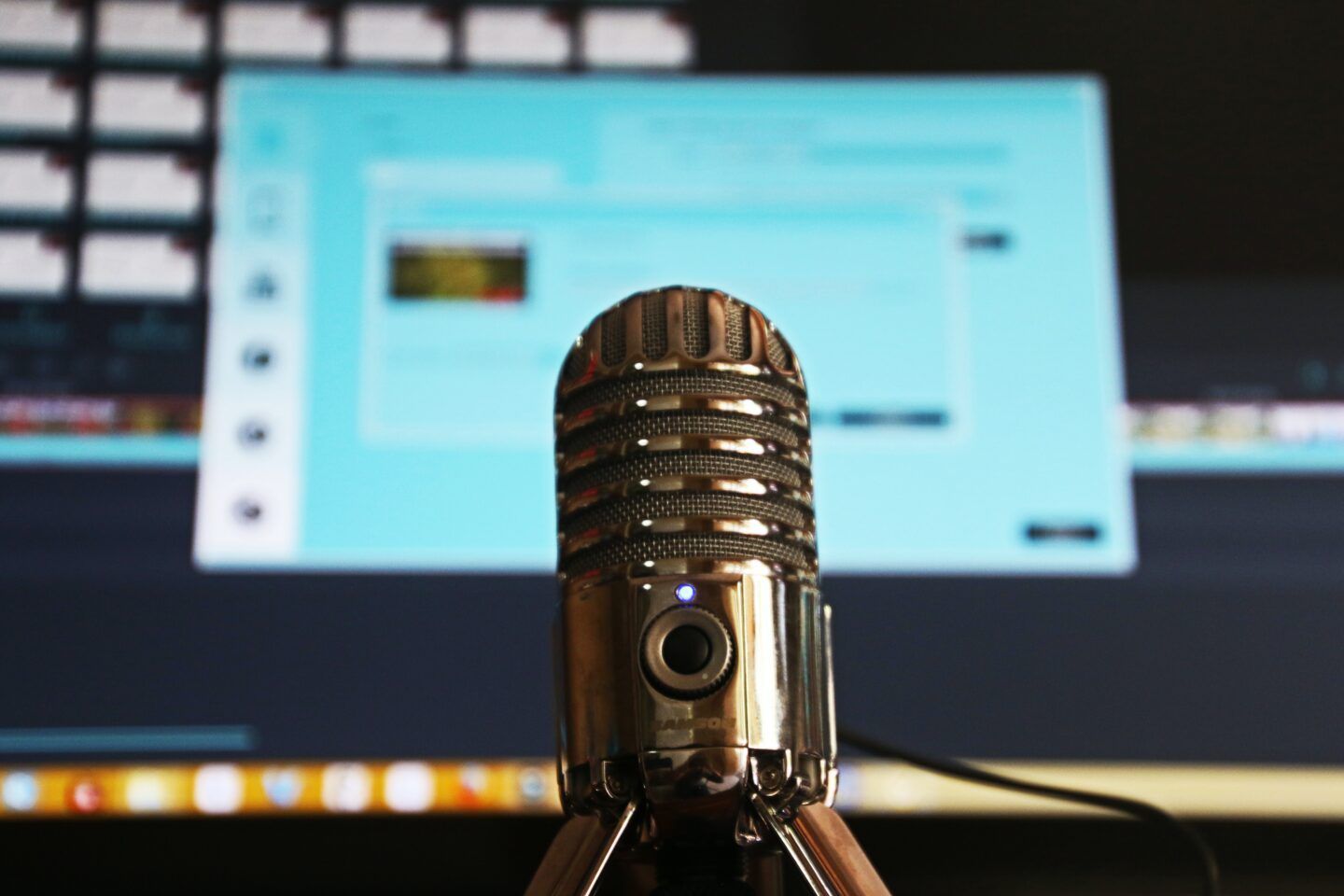My blog posts will be about a wide range of subjects (this blog is ‘a little about everything). All of them will appear in reverse order on this page, and you are welcome to scroll through. However, you may be interested in only certain subjects. To read those without having to search through them all, you can click on a category heading located at the top of each post, or a tag link found at the bottom of each post. The categories will be subjects such as Gardening, Poetry, Cooking or general Blog Posts. The tags will be sub-categories, such as Seasonal (Gardening), Poetry Author (such as Emily Dickinson), Recipes, and other similar sections. Clicking on those links will give you just the posts from that category or tag. At the beginning this will be a small number for each group, but hopefully it will make navigation easier when there are more listed here.
A New Start
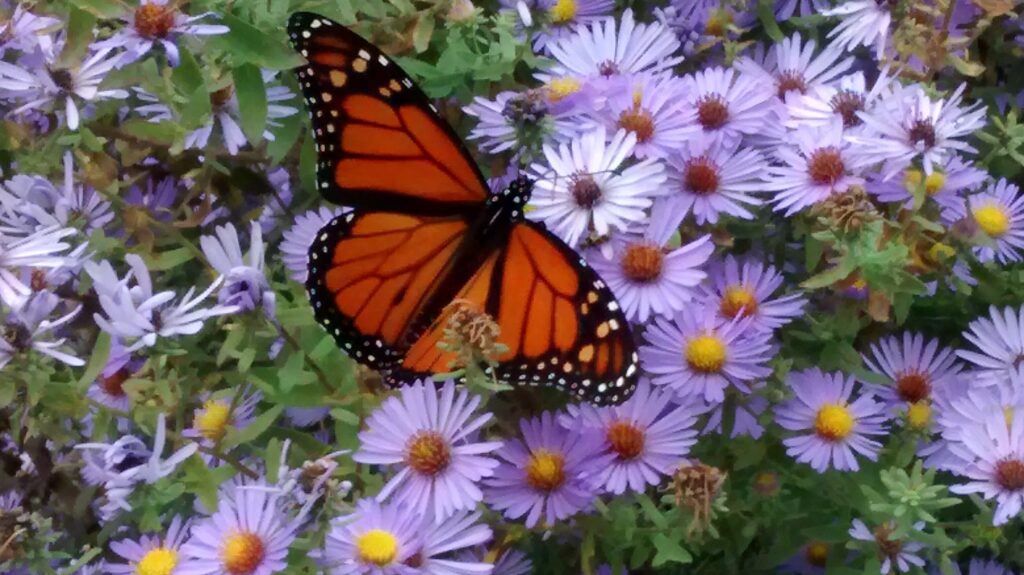
It’s the standard question for every kid – What do you want to do/be when you grow up? Once you get to be an adult, you quickly realize that the question never has a final answer, you simply change the ending – next year, in five years, in ten years. When I was a kid, the answer to the question was ‘I want to run the Smithsonian Museum.’ (I don’t think I was quite that ambitious, but hey, go big or go home!) Really, it was more about what I wanted to do, instead of where. I wanted to talk to anyone about anything they were interested in, and as a child, the Smithsonian Museum seemed like the place that had something of everything.
As an adult, the answer to the question hasn’t really changed; I still want to learn everything I can, so that I can have a conversation with anybody about their interests, and be able to contribute to the conversation. I started my career with a degree in history, and moved into the museum profession soon after. I worked for Old Salem, a living history museum, for over 20 years (not the Smithsonian, but turns out I really like living in North Carolina). Now I am looking at new career options as a graduate student in Library and Information Science at UNCG. To be honest, I think I’m still working toward my goal as a kid. Working at a library means helping people find information they want and need, and I can’t think of anything more interesting than that!
Recommendation- 3 Videos about Writing and Libraries
So, if anyone has read some of my past recommendations, you will know that I enjoy learning about languages and the history of writing. I thought I had recommended two of these videos before, but apparently I have made the mistake of not doing so yet. The third video is a lecture from Irving Finkel, who I have become familiar with as the expert on cuneiform that is always interviewed for documentaries on ancient writing. In fact, one of my favorite documentaries features him, and I will recommend that one later this month. For now, let me stick with just three, since that accounts for about three hours of viewing if you watch them all!
I will first say, if you feel like lectures are dry, boring experiences, you have never listened to Dr. Finkel give one. He is delightful to listen to, clearly loves his work, and, like many historians I have have met, wants to make sure you understand that his time period is the best! From personal experience with reading primary documents in depth, it is easy to hear how well Dr. Finkel knows the material and the people who wrote the documents. I do not have the expertise that Dr. Finkel has with cuneiform, but I recognize the ability to begin to understand personalities from just government and official documents. There were a number of times I could almost hear the sighs of frustration by the writer of the council minutes from a meeting over 200 years ago. However, the first two videos I am going to recommend are a little less like a lecture, and will take you through the beginnings of the written word and how it developed until the time of the movable type printing press
The first 2 videos are a set of documentaries from PBS NOVA. The first one is called A to Z: The First Alphabet. The second in the series is A to Z: How Writing Changed the World. While the first one is my favorite of the two, I highly recommend both of these. They are easy to follow, and tell the wonderful story of the beginning of writing, the development of the alphabet by a group of immigrants, and the way writing transformed how civilizations worked. You can find both of these videos on the PBS Passport website, or check your public library’s streaming service for Films on Demand, which carries the videos.
The third video is a talk by Dr. Finkel from the British Museum YouTube Channel. It is entitled The Great Library at Nineveh, and Dr. Finkel talks about the tablets found in the ruins of the library, some of the documents that have been translated, and what is known (and unknown) of the library’s holdings. There is also some general history about the start of the library by King Ashurbanipal of Assyria. The real fun is hearing Dr. Finkel talk about this subject as only he can!
Featured image at top is “Zine Study XIV: [language]” by Shawn Econo is licensed with CC BY-NC-SA 2.0. To view a copy of this license, visit https://creativecommons.org/licenses/by-nc-sa/2.0/
Quick and Easy Cooking: Personal Pizzas
So, again, it’s been awhile since my last post. I am going to attempt (no promises!) to post more regularly for at least the next few months. For this post, I am going to describe one of my newest ways to fix a quick, tasty meal without having to cook more than turning on the oven, or even dirty a pan much. You may have tried this before, but making a pan sized pizza using a flour tortilla is a great option for a meal.
I make pizza the standard way, though my favorite quick dough has become impossible to get, as least as far as I have found so far. I have tried the pre-made dough balls, but while that is fine to use and tastes good, it can take a bit of time to spread out, especially if you have family that prefers stuffed crust. BTW, if you do want to do a stuffed crust pizza, don’t use shredded mozzarella cheese. Use the solid block (I prefer the whole milk, but skim milk mozz is fine too). Cut it into logs as thick as you want, and roll the crust around it. Shredded just comes out onto the pizza, it never stays in the crust.
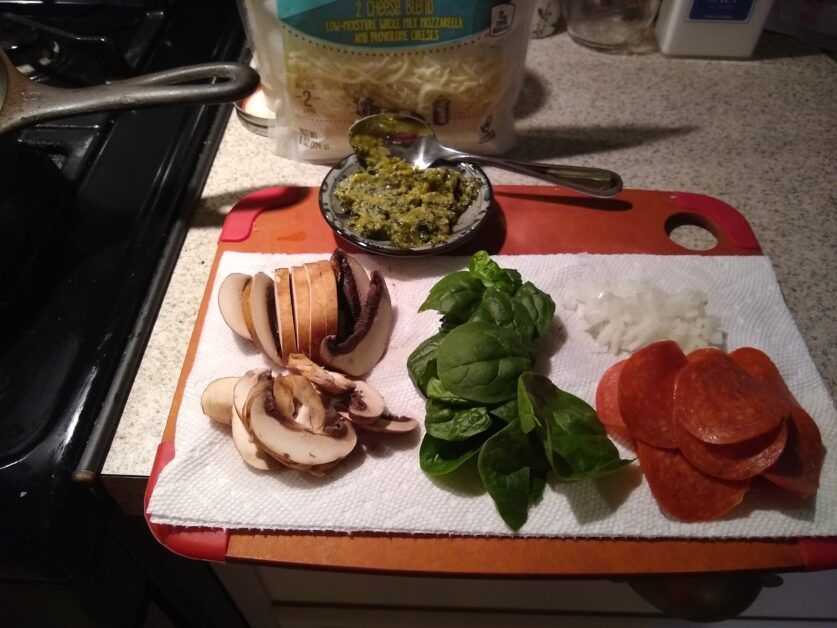
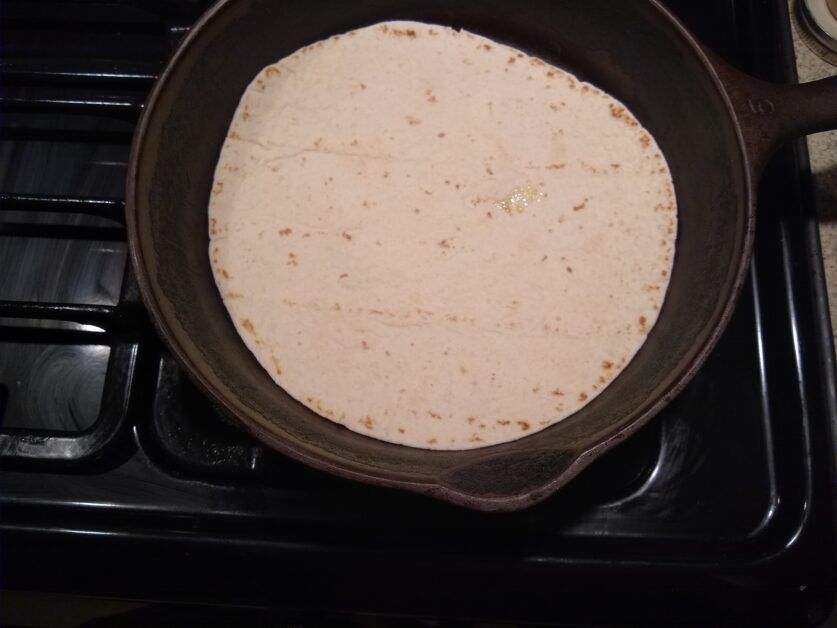
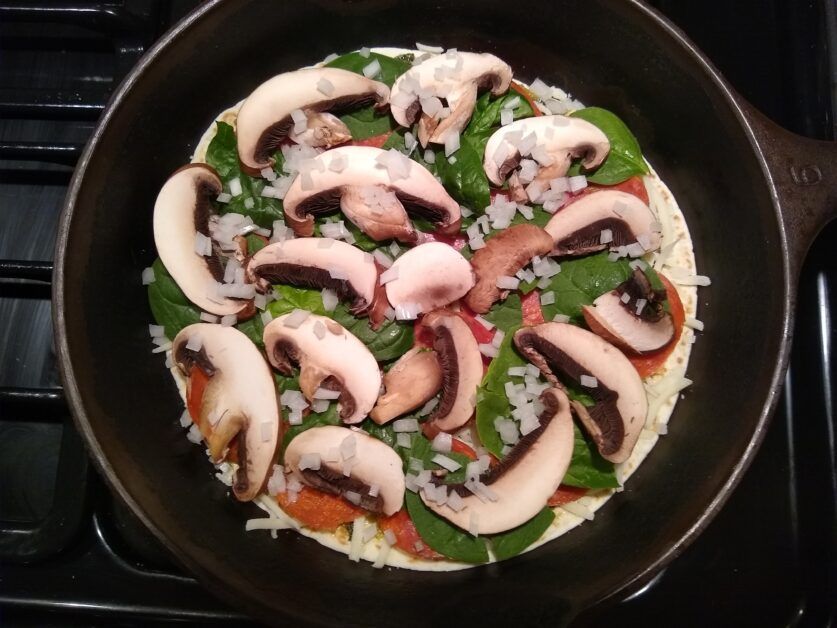
If you use this flour tortilla style pizza (or really, any tortilla is fine, you pick), then you will have a very crispy crust, and no stuffing option. However, it is super easy. I like using pesto as a sauce, because it is a little drier and doesn’t make the tortilla as moist, but tomato sauce works fine too, just be really careful not too use much. Then you just top with your favorite toppings. When using spinach or other delicate green topping, one tip is to make sure not to put them right on top, as they will burn in the high heat for pizza. If you have a cast iron pan, that is the best option, but a baking sheet is fine too. I cook the pizza at 425 or 450 degrees, and it cooks in about 10-15 minutes (depending on how you like your pizza – its a good idea to check it after 8 to 10 minutes, then keep checking until it’s done the way you like; once you learn the time you need for your pizza, you can use that time).
A quick and delicious way to have a personal pizza!
Recommendation – PBS EON series
Well, that attempt at having two postings per month did not last long! I didn’t post in February, so this is really late. It is also another recommendation for a great series on YouTube, especially for those who are interested in science and dinosaurs. If you watch YouTube much, you might have come across some of the shows from PBS Digital Studios. There are a number of them that you can watch, and they are all similar in structure and length. The one I am going to describe today is called Eons, and it is about different points in Earth’s history, from the very beginning of life up until the beginnings of the human era. The one most people might notice first are the episodes on dinosaurs, but there are a lot of other subjects covered, such as all those about species that were around earlier, sometimes much earlier, such as trilobites and crocodilians (yes, that is an actual word for an real group of animals from the Triassic period; I’m not making it up!).
I’ve watched a lot of these episodes, and I do have my favorites. There are a lot of episodes, since the series has been around for about 4 years. There are subjects for most interests, such as the evolution of insects, plants, fungi, the beginning of plate tectonics, the snowball earth, and other strange and interesting things about earth’s past. Each episode is similar – they last from 6 to 15 minutes, there are a lot of illustrations and graphics show about the subject or animals, and the narrator gives both scientific details using the latest research and the debates around that research. One thing you do have to get used to is the pace – it is fast. They actually give a lot of information in that short run time, but the amount of information means that there aren’t any pauses in the flow. So you have to pay attention, or you might be watching the video two or three times to catch everything. There are also a lot of strange words, so trying to memorize any of them calls for either a lot of concentration, or you will be looking up a lot of strange words on Google! One thing that’s provided in the Description section are the links for the research mentioned in each episode, so you can look up those subjects that catch your interest.
The narrators are generally very good, and keep the fast pace of words understandable (I know from experience that takes of a lot of work). They also have enthusiasm for their subjects, and they are usually very enjoyable to listen to. There are about 4 or 5 different hosts, and they rotate for the different episodes. I do have favorite episodes, but that has to do with the subject matter, not the host narrator. I am going to embed a couple of my favorite episodes here, but I am also including the direct link the YouTube channel for PBS Eons so you can find your own favorite!
Link- PBS Digital Studios EONS
This episode is a good introduction to how the show talks about the history of the planet, and will get you used to the different time periods.
This episode is about dinosaurs, but maybe not the ones that most people think about first! It is the story of how we began to realize that dinosaurs are still around – as birds.
This last one is just fun – its about the theory on why humans don’t have fur like most other mammals. Hearing about the ways scientists and researchers went through the process of developing theories of evolution is one of the really great things about these videos. I highly recommend trying them out!
Recommendation- Webb Telescope
Soooooo – I have really gotten behind on writing posts. In my defense, I used my holiday break to redesign a website, and then I have been getting adjusted to a new internship/practicum for this semester with NC LIVE, in addition to continuing work as a research assistant, a class, and working as an intern at the campus library. So I am going to go ahead and say that updating is going to be a spotty for a few months! I have decided to try to do at least two Recommendation posts a month, and see how that goes. If possible, I will add another post sometime in the month. It’s just a matter of getting into the habit, so here goes!
I decided to post a few embeds about the Webb Telescope that just achieved its halo orbit of the L2 point last week. It was an incredible achievement, and I was tracking it from it’s launch on December 25 to is final orbit. NASA has a great website that has updates on how it is proceeding and what is coming up. Now that the telescope is completely unfolded, and it is in place at the L2 point, there are several months of testing and getting the mirrors completely aligned for observations. I remember the same process being done for the Hubble telescope, but without all the great internet options for keeping up with it’s progress. I was taking astronomy as Hubble was being launched and tested, and I remember the excitement of waiting for the first images (which were a big problem that had to be corrected with a spacewalk).
I have been listening to a number of podcasts about the telescope, and I also wanted to know more about Lagrange Points (Webb is at L2 of 5). So in addition to the NASA JWST link, I have a YouTube video by a Scottish physicist named Scott Manly, who has a really good video explaining what the Lagrange points are and how they work. For general information about the telescope and what it is going to look for, I am including two podcasts from Vox media’s Unexplainable, which I have recommended before. These two podcasts are each about 25 minutes, and give a good overview. If you like astronomy like I do, the Webb Telescope is a great thing to be excited about!
Webb Telescope –NASA website link
You can also check out the YouTube videos of the big points of opening the telescope. They are usually about 2 hours long, but they contain a lot of information from the people actually doing the work of launching and unfolding the telescope. (The featured image for this post is from the NASA artist images of the telescope in space; you can find those from this link as well!)
General overview from Vox
Lagrange Points description
Just to tide you over!
So, November is a crazy month when one is working and finishing up class projects!
I have neglected posting this month because of being so busy with class projects while coordinating the end of semester with my work schedule. Since there is no way for me to do a full post this month, and since it is getting close to Thanksgiving, I will link to these posts from last year (when I didn’t have 2 jobs to coordinate; ah, the simpler times of full-on pandemic!). I will be making my Grandmother’s biscuits and dressing again this year, so I want to re-up my recommendation for them. If you are in the southern US, then you can get White Lilly flour and make these yourself. They really are the best!
I’ll be able to write several new posts in the month of December, and load some new pictures into the gallery. See you then!
Recommendation – Learning Microsoft Excel and Website Coding
I am late in getting this new entry posted, but I have been learning new things at a quick pace! I wanted to share two resources for anyone wanting to learn how to work with Excel sheets or how to code for websites. My class work lately has been heavy on website design, and my work as a graduate assistant has required more detailed knowledge of using Excel sheets than I had previously known. Like everyone else, I turned to the web to see what was available (and yes, I am in graduate school, but they expect me to find a lot of this information myself!). After trying several different avenues, I found two resources that I wanted to share. I have found both to be very helpful with learning and practicing new skills, so if you are interested in either, check these out!
The first is learning Excel. If you are like me, you probably have done some basic work with Excel, but never really needed to go very deep into its various uses. There are a lot of people who have to learn Excel for a job, but most people don’t deal with numbers and statistical analysis every day. However, if you want to gain a new skill on your own, I have found a set of YouTube videos that helped me a lot when working with Excel files. The person who presents these videos has a website with other resources as well, so I am going to include links for both his channel and website at the end of this section. The title of the video set is Microsoft Excel Tutorials for Beginners, and there are about 13 total videos. However, you can pick and choose which videos interest you, depending on what you want to learn. The presenter, Jamie Keet, provides a timed overview of each video, most of which are around 20 minutes. The overview allows you to jump to the sections you want to hear, or perhaps re-hear, without going through the entire video. His video is easy to follow, and he doesn’t make assumptions about what you already know. If you already know how to work with certain parts of Excel, you can always jump to the next section. (I recommend listening to the whole thing first, he provides little time saving tricks you might not know.) Mr. Keet also has a website/blog called Teachers’ Tech that has other helpful content for those wanting to learn about digital resources. I highly recommend the videos!
Microsoft Excel For Beginners and
My second recommendation is for learning HTML and CSS coding. To be honest, most people probably don’t need to learn coding if they want to create a website or use most modern digital media. However, learning is always fun, and it helps you understand how websites work. If you are using a CMS (Content Management System) like WordPress, Wix, or Weebly, learning how coding works can help you make better decisions when you are creating your digital works. And really, at least you will know why the darn thing won’t do what you want it to! For learning coding, my biggest help has been W3Schools. This website is run out of Norway, and started in 1998. It has all different types of coding lessons, and the tutorials are very simple. Some people might think they are too simple, but I have found them easy to understand and quick to go through. You will need to practice your coding by writing code (I use Atom, a free download coding software, but you can easily just use Notepad if you are on a PC). The main thing about the way this teaches coding is through gradually taking you though each part, and allowing you to open up a practice page. On the practice page you have the code on one side, and the webpage result on the other. This makes it very simple to change something and see the result right beside the code. I wouldn’t try to do much writing on the Example pages, but once you get the idea, you can work on Notepad or any other code software and try out what you are learning. If you just want to dip your toes into coding, W3Schools are really nice to use.
Featured Image by Lawrence Monk from Pixabay
Poetry – A poem from the 1600s
[As a quick aside, my work has increased a lot for the next several months, so I won’t be posting as often, and poetry is my go-to option for less involved posts. Expect several of them over the next few months!]
The poem I am going to introduce in this post is an older one, from the poet Thomas Carew, who lived from 1595 to 1640. I haven’t found an exact date for this particular poem, but approximately 1620-1640 would be likely. I mention this because the wording can be a little harder to read because of differences in language use, but it still gets the meaning across clearly. The poem is Mediocrity in Love Rejected, and is one that I enjoy because it states a truth about humanity very well. I am not sure that was the intention of the poet, who was known for his erotic (at least for the 15th century) poem titled A Rapture. The website Poetry Foundation has a good overview of Thomas Carew and his life and writings if you are interested. In all honesty, though, my interest in this poem has nothing to do with the writer, but instead with how it shows how universal is the want to feel things intensely, rather than go along peacefully. At least, we seem to want that in the abstract! I am not so sure we enjoy it nearly as much when it is happening to us.
The poem describes the two extremes of falling in love, both joy and despair. The need for one or the other, rather than a more stable, comfortable experience, seems to sum up that need for intense experiences that so many think they want. There is no effort to make this relationship peaceful! Like many of the poems I like to read, it is very good at giving a description of a complicated subject in a short summary. I have never read any other poem by this poet, and I doubt I would want to; however, this one appealed to me for some reason. See what you think!
Mediocrity in Love Rejected
Give me more love, or more disdain;
The torrid or the frozen zone
Bring equal ease unto my pain;
The temperate affords me none;
Either extreme, of love or hate,
Is sweeter than a calm estate.
Give me a storm; if it be love,
Like Danae in that golden shower,
I swim in pleasure; if it prove
Disdain, that torrent will devour
My vulture hopes; and he's possessed
Of heaven's that's but from hell released.
Then crown my joys, or cure my pain;
Give me more love, or more disdain.
Thomas Carew, 1595-1640
Growing Tomatoes – Some Personal* Experience
This post is going to be about tomatoes – yes, it probably would have been better to post this in July or August, or better yet May, when tomatoes are planted in this area! However, I don’t really do the planting and tending myself, I do more of the cooking. So for me, tomatoes are really more of an August crop, when I start to do a lot more cooking with them. (The first tomatoes are mainly for eating fresh, after the long months of having to settle for store-bought tomatoes. If that is all you have ever eaten, I feel your pain!) If you have read some of my earlier posts on gardening, you know I am not really the gardener of the family, that’s my mom. She has planted a garden every year since I was 4 years old, and tomatoes have been grown every year. And I’m not talking two or three plants. Generally the number has only gotten higher over the years, and for the last 20 or so years, its been anywhere from 40 to 60 plants. Usually about 45 is the average, and this year it was only about 37 plants. Mom went on a 4 week trip out west this summer, so she decided to ‘down-size’ the garden. (I argued, I was over-ruled. I had to do some of the picking while she was away – not my favorite thing in late July!)
So when I say ‘*some personal experience’ let me clarify that to say that I have seen how tomatoes grow since I was a kid, and I know the work someone else has done on a daily basis. What I don’t do is the main planting and tending! But I have seen a lot of the experiments tried, and on this post I’ll just share one – suckering – that is fairly easy to do, especially with just a few plants. It is also a great benefit if you are planting in a small area, because suckering helps contain the size of the plant. If you are interesting in reading more about the process, this link is a study done by Cornell University using the practice to increase yield. If you have grown tomatoes before, and never suckered them, you probably had a big plant with lots of leaves. At full size, they look like a leafy bush. Suckering prevents a lot of that leaf formation, so you will see the main stem of the plant the whole growing season. This has the benefit of allowing air to circulate, keeping moisture from causing disease, especially in areas of high humidity (hello, North Carolina). However, if you have never done it, the feeling early in the process is that you are going to either kill the plant or not have any tomatoes. I promise, done right, suckering will actually help with production!
When growing, a tomato plant will put out alternating leaves on each side as it grows up, and each leaf will begin a new stem that grows out from the main stem. As that stem grows bigger, another small leaf will form at the juncture of the main stem and the side stem. That new leaf is a ‘sucker’. It too will grow into a new stem. This will happen at every stem juncture, for the entire early growing season. Basically, you end up with a bush that has multiple large stems. ‘Suckering’ is removing that extra leaf before it has a chance to grow into a new stem. This way, you keep one main stem at the center of the plant, and all side stems are limited to just one on each side of the main as you go up. Since you prevent the plant from putting effort into all that green stuff, it puts more effort into fruiting. As a gardener, you want the fruit, so suckering means you get bigger tomatoes when you sucker for the first 6 to 8 weeks of growth . After that it usually isn’t worth continuing, since most of the plant growth will go into producing fruit (there may be a small drop in number, but their greater size will more than make up for it).
What does all this mean? Well, usually we don’t bother to sucker cherry tomatoes that we plant, because they are supposed to be small, and the plants just grow too fast to bother with the work of suckering them. However, last year mom forgot which plants were cherry and which were regular tomatoes in a small section, and suckered one row of the cherry tomato plants, while leaving the others to grow out. So we had a natural experiment. All the cherry tomatoes were in the same area, they all got basically the same water and sun, and we harvested tomatoes from both plants. Here is a picture I took comparing them side by side. Remember, these are the same type of cherry tomato, the only difference is that one set of plants were suckered, and the others were not.
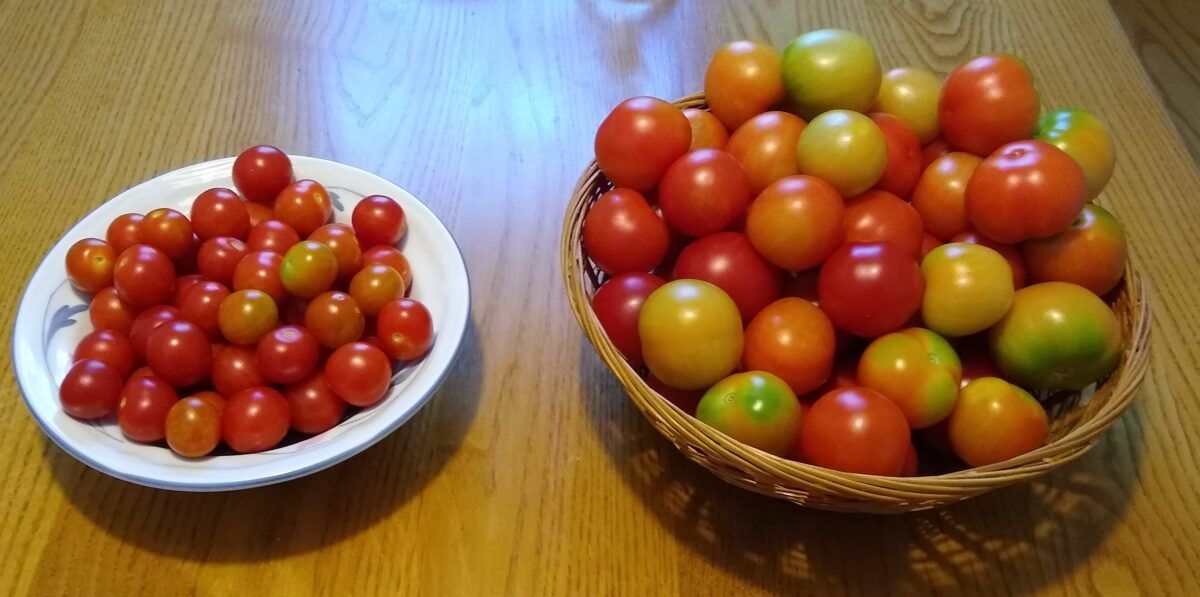
Want to guess which is which?
Poetry – Emily Dickinson #2 (+ Stephen Crane)
Well, I decided to include two poets for this post, in part because of all that is happening right now with Afghanistan, and in part with the rise in Covid again. You might think that I pick out a lot of poems that seem to talk about sadness or grief, and that is probably true. I think poetry is one of the better ways to express emotions that are hard to discuss in regular conversation. Also, the best poetry has a way of getting to the heart of issues, which is one of the biggest reasons I like reading it. So for this post, I am going to highlight an Emily Dickinson poem about loss, and one by Stephen Crane on war.
Emily Dickinson wrote a lot of poems about grief and loss, and I think many of them are some of the best on those subjects. This poem is just 8 lines, but it conveys the first reality of loosing someone, no matter how strong a religious faith they may have. In many of her poems, Dickinson seems to have a very realistic and slightly sarcastic view of humanity (I like snark, and no matter what century a writer comes from, you can always identify those who recognize humanity’s foibles). When dealing with personal loss, she was much more likely to be straight-forward, and break it down to basic emotions. At least, that is how I have experienced her poetry. You may disagree! For me, it is hard to better express grief and loss than the last two lines of this poem –
My life closed twice before its close
It yet remains to see
If Immortality unveil
A third event to me
So huge - so hopeless to conceive
As these that twice befell.
Parting is all we know of heaven,
And all we need of hell.
Emily Dickinson
Now that we have talked about death, let’s look at war (yes, I know, pretty grim stuff). Stephen Crane was often writing about war; his most famous book was about Civil War soldiers on the Union side, The Red Badge of Courage. Crane often wrote about starting out with the idea of glory in war, only to be disillusioned by its reality. This poem was part of a book of poems, though I have never read all of them as a group. Like with Dickinson’s poem above, I think this one captures the end of a war in very few words, especially the confusion around why the war had been fought. As I see so much just in the last week on various explanations, analysis, excuses and reasons for the Afghanistan war, I thought of this poem, and I think that Stephen Crane had a lot right about our reactions, no matter the time period.
Poem 14
There was crimson clash of war
Lands turned black and bare;
Women wept;
Babes ran, wondering.
There came one who understood not these things
He said: 'Why is this?'
Whereupon a million strove to answer him.
There was such intricate clamor of tongues,
That still the reason was not.
Stephen Crane, The Black Riders & Other Lines, 1905
Learning Video Editing
One of the areas I have been focused on learning during my graduate work is digital technology. While I have been familiar with the general Microsoft products and use the internet for many activities and work, there are always new things coming out that I wanted to make sure I learned while I was getting a new degree and discovering a new career. While it may seem strange, I used digital technology a bit in my museum job, especially in research, but also in creation. I worked with the behind the scenes systems that any museum has to use to reach its visitors, and in general, I like the combination of face-to-face interaction combined with digital outreach. Each has a place, and strengths and weaknesses. The job of a programming designer is to know the best way to use both. So during my graduate work, I have been pushing myself to learn new things, and take chances when I can. This website is a direct result of that. When given a choice, instead of just creating a student profile as a digital page, I decided to create a full website and blog. It might have been a throw-away option, but I decided that there was no point in going small, better to go big and learn as much as possible in this new realm!
I can easily say that was the best decision I have made so far in my graduate work. By forcing myself to learn how a website is put together (I will admit there was a bit of cursing, but it was privately!), I have been able to work better and with more focus on later projects, such as creating a LibGuide. After that choice, it also wasn’t hard to go ahead and spend the money for a video editing software package after researching the options and asking a professor for advice. I decided to get Camtasia, because that software had a lot of support online for helping me learn the techniques, and a professor used it a lot and recommended it as a solid video editing program.
And so began my efforts to learn video editing. I will admit to being unsure about whether I had made a good choice at first, since there are a number of free video apps available, but over the last two months I have come to see I made a good decision for learning how to do this work. And I also have come to really like doing it! Video creation and editing is a bit like making a puzzle – there are a lot of little parts that have to fit together to create the whole picture, and you have to look at them individually and see them as a part of that whole, even if they don’t look like the fit at first. The first video I created was a simple instructional video, to describe how to do a Boolean search. For the second I had to film myself giving a book talk, then edit the result (I added an entrance shoot, so I learned how to cut and paste in that section,) The next two efforts were considerably better, a Book Trailer and a PSA about the importance of public libraries.
For the book trailer, I pulled images from the book I had chosen in my Children’s Literature class. The storyboarding process was simple, creating the basic outline I wanted for the trailer. Then I used Microsoft 3D Paint to create effects and the still images I needed. From that point, everything was about the editing process, putting the images in order, layering tracks to create the narrative for the trailer, and then picking out music and layering it onto the video. I really enjoyed the process, and I learned a lot while I was doing it.
The next project, the last to date, was a PSA that I entitled Public Libraries: They’re Where It’s At! This one I had six tracks layered together, two sound and four video. Working with the pacing, and playing it over and over to make sure that each picture and effect was up just long enough, but kept the video moving, was the trickiest part. But I think the result wasn’t bad. I still have a lot to learn, but this is a skill that I believe will continue to be useful in many areas, and especially in Outreach Programming.
(Header image: Photo by Magda Ehlers from Pexels)


